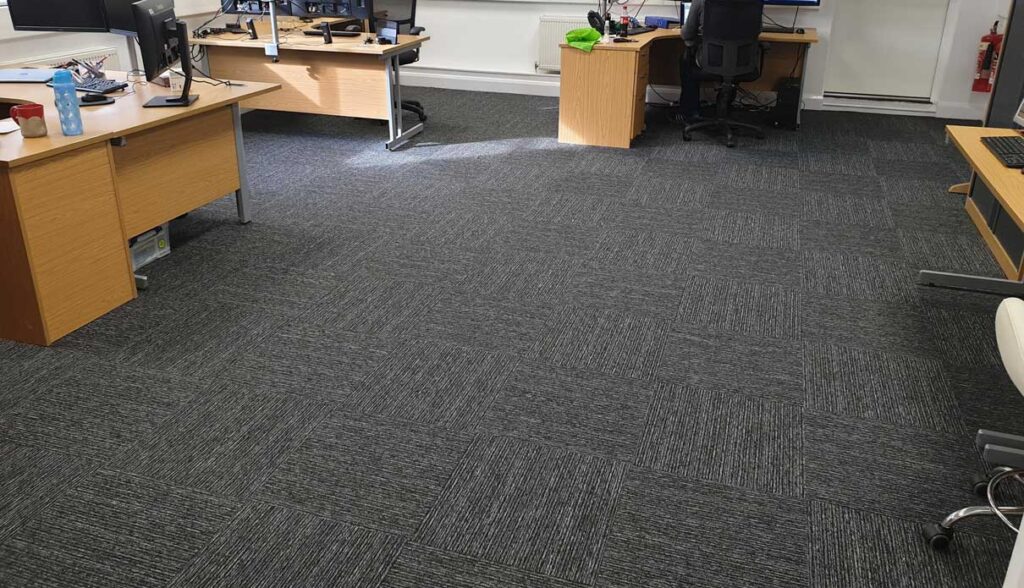
When it comes to designing a comfortable and productive office environment, flooring is one of the most important yet often overlooked elements. The right choice of flooring can influence not just the look of your workspace, but also how it feels and functions on a daily basis. Among the many flooring options available, carpets remain a popular choice for modern offices thanks to their ability to enhance aesthetics, absorb sound, and create a welcoming atmosphere for both staff and visitors.
Office carpets do far more than cover the floor — they help reduce noise levels in busy open-plan areas, offer warmth underfoot, and can even contribute to better air quality by trapping dust and allergens. However, not all carpets are created equal, and selecting the best type for an office setting requires careful consideration of factors such as durability, maintenance, style, and budget.
In this article, we’ll guide you through the different types of carpets suited for office environments, explore the pros and cons of various materials and styles, and provide practical advice to help you make an informed decision for your workspace.
Factors to Consider When Choosing Office Carpet
Before deciding on the type of carpet to install in an office, it’s important to think about how the space is used and what practical demands it places on the flooring. A carpet in a busy reception area will face different challenges compared to one in a private office or boardroom. Here are some key factors to keep in mind:
Foot Traffic
Consider how many people will be using the space daily. High-traffic areas, like corridors, meeting rooms and reception areas, require a carpet that’s durable, hard-wearing and able to maintain its appearance over time. In quieter, private offices, you may have more flexibility to opt for softer or more luxurious finishes.
Acoustic Performance
Modern open-plan offices can quickly become noisy environments, with conversations, phone calls and the movement of people and chairs creating a constant background hum. A good quality carpet can absorb sound, helping to reduce noise levels and create a calmer, more productive working atmosphere.
Ease of Maintenance
Offices naturally experience spills, dirt and general wear, so it’s essential to choose a carpet that’s easy to clean and resistant to stains. Low-maintenance materials and modular options like carpet tiles allow for quick and easy replacements in the event of damage.
Aesthetic Appeal
Carpets contribute to the overall look and feel of an office. The colour, texture and design you choose should complement your company’s branding and interior décor. Neutral tones often work well in professional settings, while bolder patterns might suit creative or relaxed environments.
Budget
Finally, it’s important to strike a balance between quality and affordability. While it’s tempting to cut costs, investing in a durable, high-performance carpet will save money in the long run by reducing the need for frequent replacements and repairs.
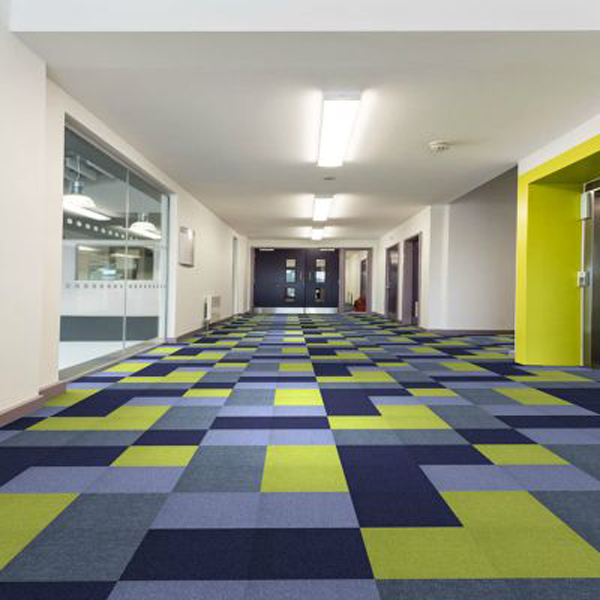
Types of Carpet Materials for Office Use
Once you’ve considered the practical requirements of your office space, the next step is choosing a suitable carpet material. Each type has its own strengths, limitations and price points, making it important to pick one that matches both your needs and your budget. Here’s a breakdown of the most popular materials for office carpets:
Nylon Carpet
Nylon is one of the most widely used materials for commercial carpeting. It’s highly durable, resilient, and resistant to stains and wear, making it ideal for high-traffic areas like hallways, lobbies and open-plan workspaces. Nylon also holds its colour well, maintaining its appearance even in busy, sunlit areas.
Polypropylene (Olefin) Carpet
Polypropylene is a budget-friendly option that offers excellent moisture resistance. While it’s not quite as durable as nylon, it performs well in low to medium-traffic areas and spaces prone to spills, such as staff kitchens or waiting areas. It’s also resistant to mildew, making it suitable for basements or ground-floor offices.
Wool Carpet
A premium, natural material, wool is prized for its luxurious feel, durability and eco-friendly credentials. It’s naturally resilient, easy to clean, and offers excellent insulation against both noise and heat. However, wool is typically more expensive than synthetic alternatives and may not be the most practical choice for very busy, high-traffic areas.
Polyester Carpet
Polyester carpets are known for their vibrant colour options and soft texture. While they are generally less hard-wearing than nylon, they can be a good choice for executive offices, meeting rooms, or areas with less foot traffic. Polyester is also stain-resistant, although it may show signs of wear more quickly in busier parts of the office.
Blended Carpets
For a balanced option, many office carpets are made from a blend of materials — commonly wool and nylon. This combination offers the softness and natural appearance of wool with the strength and resilience of nylon, making it a practical yet premium choice for commercial interiors.
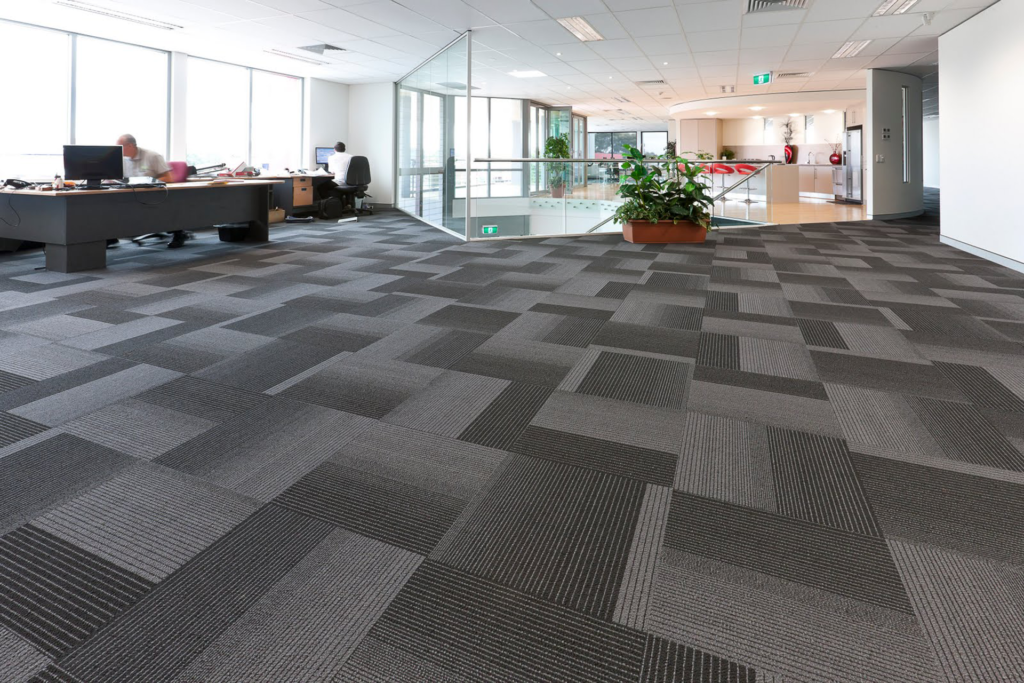
Best Carpet Styles for Office Settings
Beyond material, the style and construction of a carpet play a major role in how well it performs in an office environment. Different carpet styles offer varying levels of durability, comfort and design flexibility, so it’s important to choose one that suits both the aesthetic of your workspace and its practical demands. Here are some of the most suitable carpet styles for offices:
Carpet Tiles (Modular Carpets)
Carpet tiles have become a popular choice for modern office spaces, and for good reason. They’re easy to install, simple to replace, and available in a wide variety of colours, patterns and textures. If a section becomes stained or worn, you can swap out individual tiles without needing to replace the entire carpet. This makes them particularly cost-effective for high-traffic or flexible office environments.
Broadloom (Wall-to-Wall) Carpet
Broadloom carpet is supplied in large rolls and installed from wall to wall, offering a smooth, seamless appearance. It’s a good option for executive offices, conference rooms and quieter areas where a more luxurious, uniform look is desired. While broadloom can be slightly more challenging to maintain in the event of stains, it delivers excellent acoustic benefits and can make a space feel warm and inviting.
Loop Pile Carpet
Made from uncut loops of yarn, loop pile carpet is known for its strength and durability. It resists crushing and matting, making it ideal for high-traffic corridors, reception areas and communal spaces. Loop pile styles also tend to show less dirt and footprints, helping to keep the office looking tidy between cleans.
Cut Pile Carpet
Cut pile carpet has the yarn loops cut at the top, creating a softer and more plush surface. While it offers a comfortable feel underfoot, it may be better suited to private offices, meeting rooms or areas with lower foot traffic, as it can show signs of wear and flattening over time.
Patterned and Textured Carpets
Patterned or textured carpets are excellent for concealing dirt, stains and wear marks. Available in both carpet tile and broadloom formats, they add visual interest to the office and can help define different areas within an open-plan layout. Patterns can range from subtle, tonal designs to bold, statement-making motifs, depending on the desired effect.
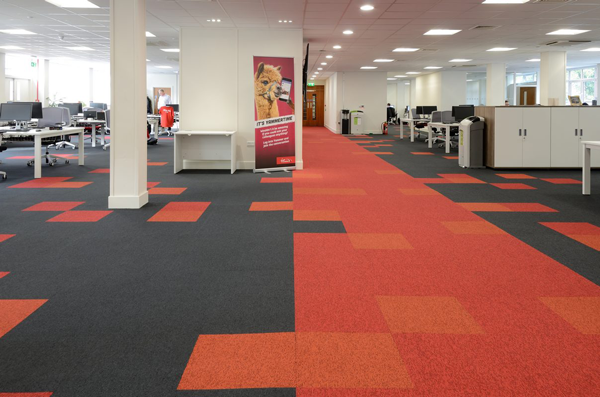
Carpet Backing and Cushioning Considerations
While the surface material and style of a carpet are important, what’s underneath also plays a crucial role in its overall performance, comfort and longevity. The right carpet backing and cushioning can make a significant difference, especially in a busy office environment.
Importance of Proper Backing
The backing is the layer attached to the underside of the carpet, providing stability, support and protection against stretching or shifting. A strong backing ensures the carpet stays in place, even under heavy office furniture and frequent foot traffic. It also contributes to the carpet’s overall durability.
There are different types of carpet backing to consider:
- Woven Backing: Highly durable and commonly used for high-quality, commercial-grade carpets.
- Tufted Backing: A popular, cost-effective option suitable for most office areas.
- Felt Backing: Offers extra cushioning but may not be as durable in high-traffic spaces.
- Rubber or PVC Backing: Often used with carpet tiles, providing excellent grip and moisture resistance.
The Role of Underlay/Cushioning
An underlay, or carpet cushion, sits between the carpet and the floor, improving underfoot comfort, insulation and sound absorption. It also helps prolong the life of the carpet by reducing the impact of foot traffic and furniture. Thicker or denser underlays are particularly beneficial in offices where noise reduction and comfort are priorities, such as meeting rooms and executive suites.
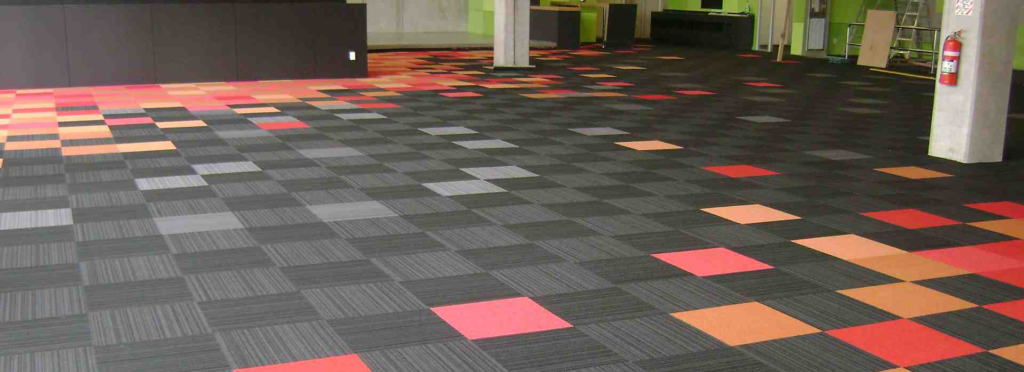
Maintenance and Longevity of Office Carpets
Once your office carpet is installed, keeping it in good condition is essential for maintaining a professional appearance and ensuring a healthy, pleasant working environment. The lifespan of a carpet in an office setting depends not just on the material and style you choose, but also on how well it’s maintained.
Regular Cleaning
Offices typically experience higher foot traffic than residential settings, which means dirt, dust and debris build up quickly. Regular vacuuming — ideally daily in high-traffic areas — is essential to prevent dirt from settling into the fibres and causing premature wear. Periodic professional deep cleaning can also help refresh the carpet’s appearance and improve indoor air quality.
Stain Management
Spills and stains are inevitable in a busy office, whether it’s from coffee, ink, or food. Choosing a stain-resistant carpet material, like nylon or polypropylene, makes spot cleaning much easier. It’s also worth having a clear cleaning procedure in place and keeping appropriate cleaning products on hand to deal with stains as soon as they occur.
Routine Inspections
Regularly inspecting the carpet for signs of wear, fraying or damage can help identify areas in need of attention before problems become more widespread. With carpet tiles, damaged sections can be quickly replaced without disrupting the entire floor, making maintenance more cost-effective and straightforward.
Protecting High-Traffic Areas
Using entrance mats, chair mats and runners in areas of particularly heavy use can help extend the life of your office carpet by reducing direct wear. Rearranging furniture occasionally can also prevent excessive crushing of carpet fibres in specific spots.
Conclusion
Choosing the right carpet for your office is about much more than aesthetics — it’s a decision that affects daily comfort, noise levels, safety and even air quality within your workspace. By carefully considering factors like foot traffic, maintenance needs, acoustic performance and budget, you can narrow down your options and select a carpet material and style that suits your business’s practical and design requirements.
Carpet tiles, broadloom, loop pile and cut pile styles each offer distinct advantages, while materials such as nylon, polypropylene, wool and blends provide a range of options to suit different office environments. Don’t forget to factor in the importance of backing, underlay and a consistent maintenance routine to ensure your investment stands the test of time.
Whether you’re refurbishing an open-plan office, fitting out a meeting room or refreshing a reception area, choosing the right office carpet can enhance the overall look, feel and functionality of your workspace — creating an environment where both employees and clients feel welcome, comfortable and productive.
Recent Comments